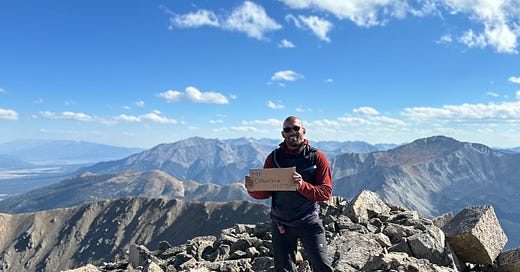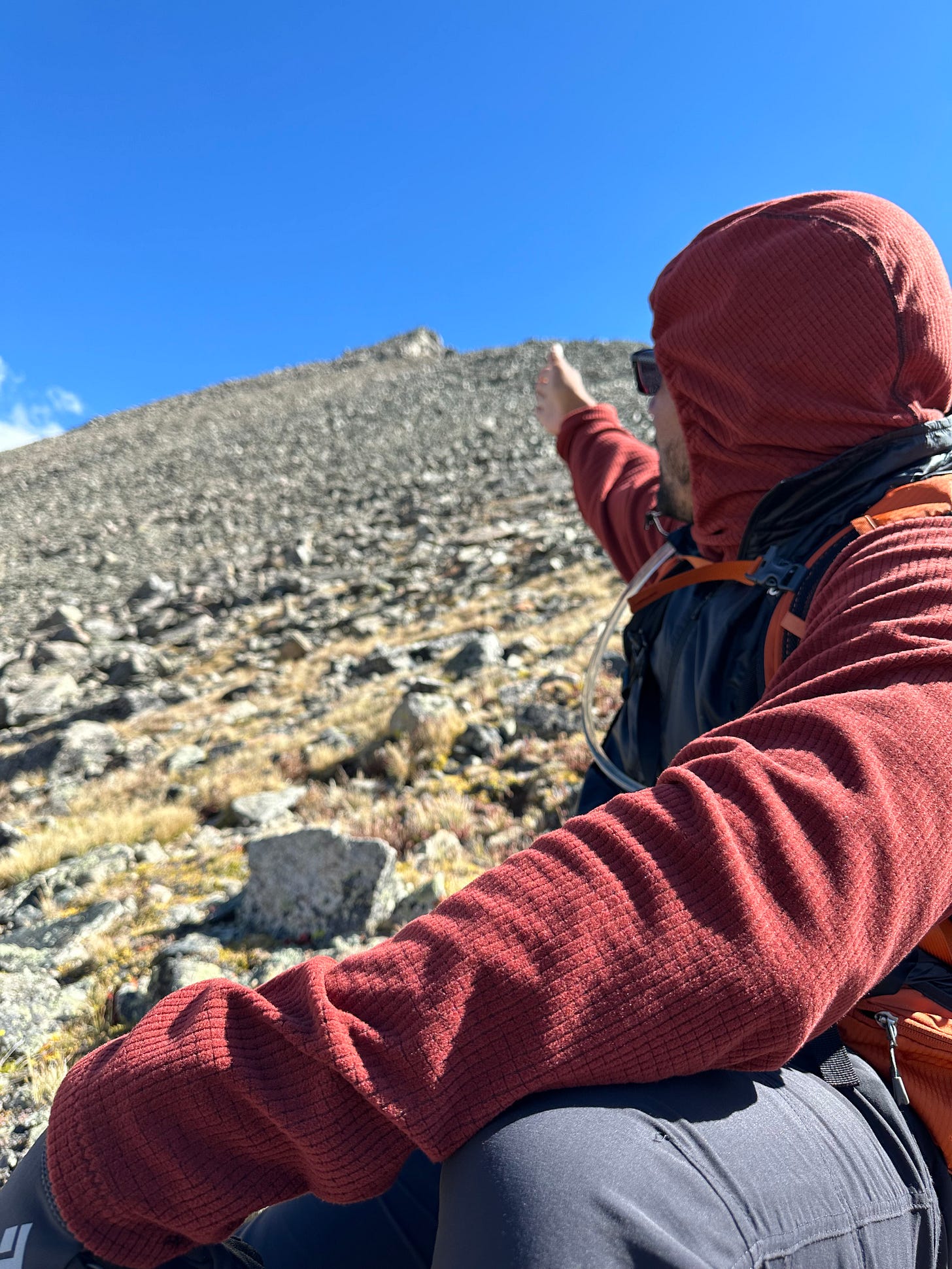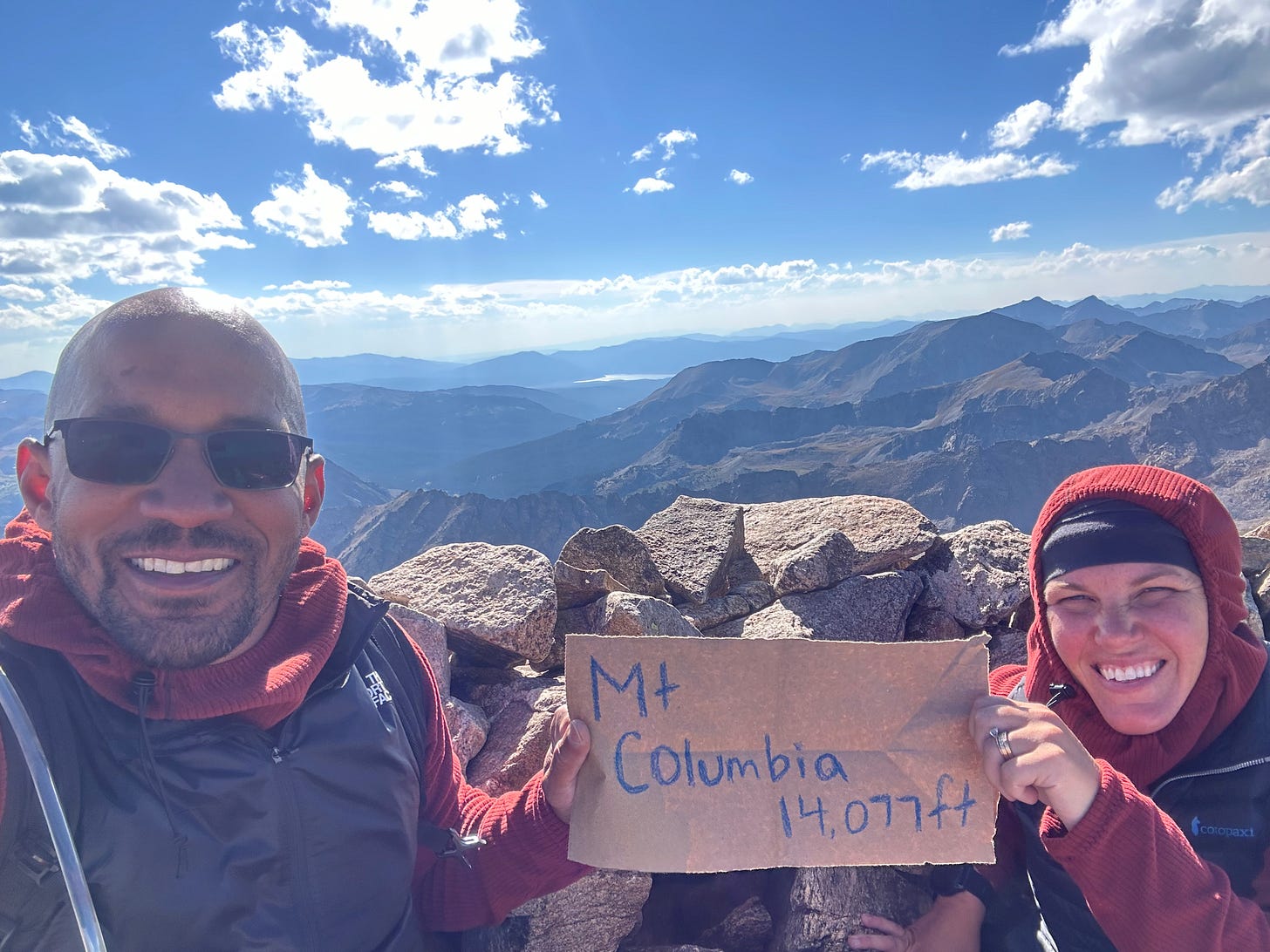The View From 14,000 Feet
Progress is growing through old discomforts to become prepared for new ones.
If you're in the Chippewa Valley this week, please join us for a free screening and panel discussion of the documentary "Beyond the Bridge: A Solution to Homelessness." Reserve your free seat at the Pablo Center: https://www.pablocenter.org/events/detail/a-screening-of-beyond-the-bridge-a-solution-to-homelessness-676051
Alicia and I arrived at Cottonwood Trailhead at 3:45am with all the necessary equipment, including windbreaker vests, camelbacks and canteens for water, global positioning technology, and enough carbs and simple sugars to make up for the caloric deficit which occurs when one tackles two 14,000-foot mountains in one day—known as ‘fourteeners’ in the hiking world. It was dark as we started our ascent, headlamps illuminating the path ahead. I heard water running to our right, but we couldn’t see the sharp drop to the river, nor the steep embankment on our left. Alicia said it was probably best it was so dark, because she didn’t know how comfortable she’d be traveling so close to the edge. Though we both enjoy hiking, she was the expert in this case, having founded a company called We Adventure which organizes guided backpacking trips. She’d recently hiked this same area a few weeks prior with a group of women.
At sunrise, we emerged from the treeline. The thin air burned every muscle in my body, and I could feel the oxygen deprivation when I moved quickly or exerted even a modicum of physical effort. We took shortened steps and kept our pace steady but slow. There was no measure of comfort at any moment when we were in motion. Only when we stopped for a short break and sat down did my body feel like something akin to comfort could arrive, if only I sat very still for a very long time.
The view from above the treeline was worth it: the sunrise on Mount Harvard and the other Collegiate Peaks was magnificent. Maybe it was enough to just clear the treeline and then descend, but going halfway wasn’t what we set out to do, no matter how uncomfortable.
I kept thinking, “If I wait until I’m ready, I’ve waited too long.” That thought helped me stand up and take small steps toward the top of the mountain. Hiking can narrow one’s thoughts to just the immediate discomfort and how to mitigate or alleviate it. It can also lead to such thoughts like, “How did I get here?” And, “Why am I doing this?” If you had asked me ten years ago if I would summit two fourteeners in one day, I would’ve asked, “What’s a fourteener?”
At the top of Mount Harvard, Alicia and I both felt the burn of the altitude. I thought I might pass out a few times. Along the path to the summit were small piles of rocks stacked up on top of one another, which Alicia told me were called cairns. The stacks served as guideposts, reassuring us we were on the right path. It also reminded us how someone else had been here before us, and they kept going.
As we descended, passing the cairns again, I thought again about how unrecognizable my life is now compared to a decade ago, yet the discomfort I felt in the wilderness of Colorado had an unlikely parallel: it reminded me of being homeless.
What did hiking back-to-back fourteeners in Colorado’s Collegiate Peaks have in common with being homeless? There are some straightforward, surface-level analogies: you sleep outside, you may have a difficult time finding food or water and may go without, you’re at the mercy of the weather, and above all, you’re uncomfortable.
In the winter of 2010, I was released from the Dane County Jail into a blizzard. I’d been held for eight days with disorderly conduct, obstruction, and failure to pay a cab driver. I’d been struggling with untreated mental health challenges after two combat tours in Iraq, and often self-medicated with alcohol, among other things. The more I tried to escape the discomfort of my mental health challenges using maladaptive coping mechanisms meant to make me temporarily more comfortable, the worse my external circumstances became. Being released from jail into a literal blizzard was the peak of it. My property, including my coat, was held in an off-site inmate property storage. I was given a tag so I could retrieve my things when the off-site storage opened for the day, but I didn’t have a car or a place to stay in the meantime. I walked out of the jail into white-out conditions, in a city I barely knew.
This wasn’t my first time going unhoused. I was fourteen when I first experienced homelessness. At night I wedged myself between two houses, as low to the ground as I could, to shelter from the wind and cold, and because I was still afraid of the dark, of the imaginary and real monsters who go bump in the night. Scared and missing my mother, I would’ve done anything to alleviate the pain I felt, even for a moment. And as an adult, just weeks before my incarceration in Madison I was unhoused in Seattle, living on a fishing boat during the work season, but when the boat was docked and work ended, it was difficult to find affordable shelter. Again, I would’ve done anything to alleviate the pains of being unhoused. I often went to bars and met people who gave me places to stay.
Back on the streets in Madison in 2010, fresh out of jail and in desperate need of a coat and basic comforts, I broke into someone’s house and took a jacket, some change, a football, a laptop, and a bottle of alcohol. And then I committed two more burlglaires. I was arrested that morning.
When I was unhoused, the only people who treated me like an equal were my fellow unhoused friends. It seemed like well-adapted folks looked at us with pity and condescension. It felt like we were all scaling the same mountain, but their trails were marked by cairns and guiding them clearly upward, while my unmarked trail sent me deeper and deeper into the wilderness and its dangers. It took a long time for me to face the discomfort of addressing my mental health challenges and substance use. When I did, I met other people who were walking the same path, and realized the people who had come before us had left cairns to guide us, hard-won guideposts based on their own lived experience.
Now I am 40 and standing atop a 14,000-foot mountain, which feels lifetimes away from some of the coldest and darkest nights of my youth. Yet I am aware of how many are still struggling to climb up out of their circumstances. I devoted myself to peer support mentorship because I know there are so many like me who still face the difficulties of housing insecurity, substance use, and mental health challenges. People were there for me when I needed help along the way, and I could not have faced those obstacles without their guidance. I owe so much to the people who taught me to turn toward discomfort, reassuring me that progress would be waiting on the other side.
After reaching the summit of Harvard, Alicia and I descended and then trekked to Mount Columbia, summiting our second fourteener in a seventeen-hour endeavor. I’m lucky to have a partner like Alicia who has been there for me on the literal and metaphorical hard treks, and who is also committed to her own growth, even in the face of discomfort. On the trails, we passed other hikers in similar states of discomfort, all of us determined to forge ahead, recognizing that growth is uncomfortable. Sometimes progress doesn’t come easy, and requires trading old discomforts for new ones. But it’s worth it when the arduous hike includes the clarifying perspective of 14,000 feet, or the ability to look back and see how far we’ve come together
.






